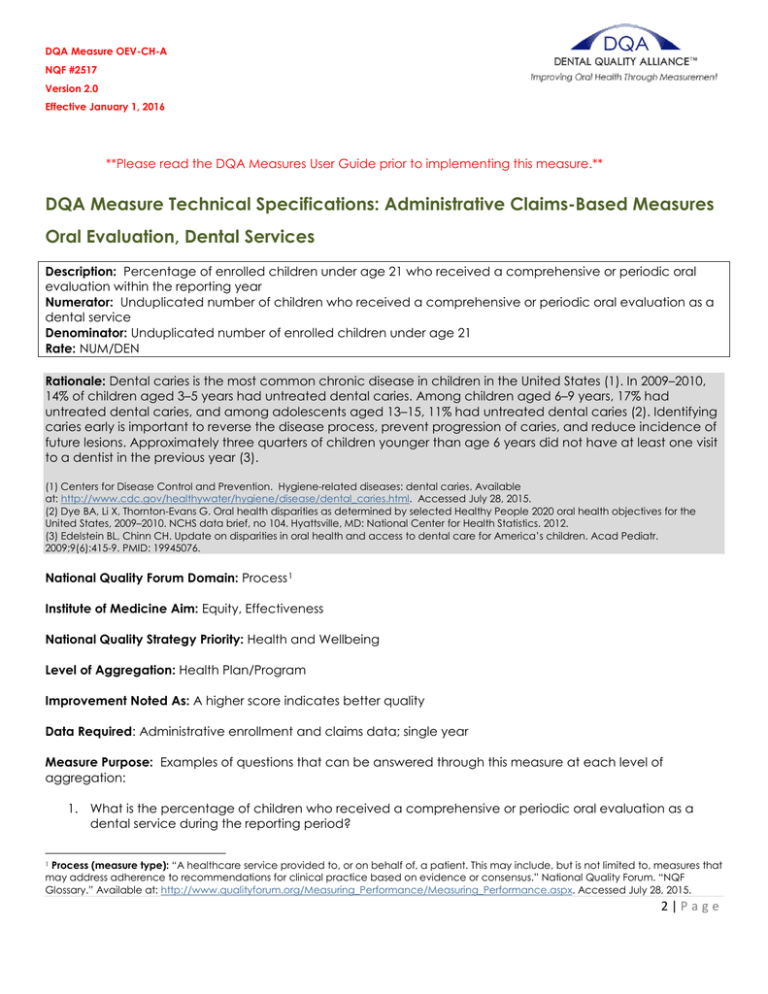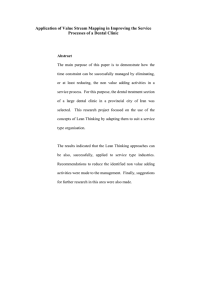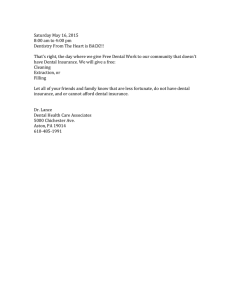
DQA Measure OEV-CH-A
NQF #2517
Version 2.0
Effective January 1, 2016
**Please read the DQA Measures User Guide prior to implementing this measure.**
DQA Measure Technical Specifications: Administrative Claims-Based Measures
Oral Evaluation, Dental Services
Description: Percentage of enrolled children under age 21 who received a comprehensive or periodic oral
evaluation within the reporting year
Numerator: Unduplicated number of children who received a comprehensive or periodic oral evaluation as a
dental service
Denominator: Unduplicated number of enrolled children under age 21
Rate: NUM/DEN
Rationale: Dental caries is the most common chronic disease in children in the United States (1). In 2009–2010,
14% of children aged 3–5 years had untreated dental caries. Among children aged 6–9 years, 17% had
untreated dental caries, and among adolescents aged 13–15, 11% had untreated dental caries (2). Identifying
caries early is important to reverse the disease process, prevent progression of caries, and reduce incidence of
future lesions. Approximately three quarters of children younger than age 6 years did not have at least one visit
to a dentist in the previous year (3).
(1) Centers for Disease Control and Prevention. Hygiene-related diseases: dental caries. Available
at: http://www.cdc.gov/healthywater/hygiene/disease/dental_caries.html. Accessed July 28, 2015.
(2) Dye BA, Li X, Thornton-Evans G. Oral health disparities as determined by selected Healthy People 2020 oral health objectives for the
United States, 2009–2010. NCHS data brief, no 104. Hyattsville, MD: National Center for Health Statistics. 2012.
(3) Edelstein BL, Chinn CH. Update on disparities in oral health and access to dental care for America’s children. Acad Pediatr.
2009;9(6):415-9. PMID: 19945076.
National Quality Forum Domain: Process 1
Institute of Medicine Aim: Equity, Effectiveness
National Quality Strategy Priority: Health and Wellbeing
Level of Aggregation: Health Plan/Program
Improvement Noted As: A higher score indicates better quality
Data Required: Administrative enrollment and claims data; single year
Measure Purpose: Examples of questions that can be answered through this measure at each level of
aggregation:
1. What is the percentage of children who received a comprehensive or periodic oral evaluation as a
dental service during the reporting period?
Process (measure type): “A healthcare service provided to, or on behalf of, a patient. This may include, but is not limited to, measures that
may address adherence to recommendations for clinical practice based on evidence or consensus.” National Quality Forum. “NQF
Glossary.” Available at: http://www.qualityforum.org/Measuring_Performance/Measuring_Performance.aspx. Accessed July 28, 2015.
1
2|Page
DQA Measure OEV-CH-A
NQF #2517
Version 2.0
Effective January 1, 2016
2. Over time, does the percentage of children who receive a comprehensive or periodic oral evaluation
stay stable, increase, or decrease?
Applicable Stratification Variables
1. Age: <1; 1-2; 3-5; 6-7; 8-9; 10-11; 12-14; 15-18; 19-20
3|Page
DQA Measure OEV-CH-A
NQF #2517
Version 2.0
Effective January 1, 2016
Oral Evaluation Calculation
1. Run records for one reporting year for paid and unpaid claims. 2
2. Check if the enrollee meets age criterion 3 at the last day of the reporting year:
a. If age criterion is met, then proceed to next step.
b. If age criterion is not met or there are missing or invalid field codes (e.g., date of birth), then STOP
processing. This enrollee does not get counted in the denominator.
3. Check if subject is continuously enrolled for at least 180 days: 4
a. If subject meets continuous enrollment criterion, then include in denominator; proceed to next
step.
b. If subject does not meet enrollment criterion, then STOP processing. This enrollee does not get
counted in the denominator.
YOU NOW HAVE THE DENOMINATOR (DEN) COUNT: All enrollees who meet age and enrollment criteria
4. Check if subject received an oral evaluation as a dental service:
a. If [CDT CODE] = D0120 or D0150 or D0145, AND
b. If [RENDERING PROVIDER TAXONOMY] code = any of the NUCC maintained Provider Taxonomy
Codes in Table 1 below, then include in numerator; proceed to next step. 5
c. If both a AND b are not met, then the service was not provided as a “dental service”; STOP
processing. This enrollee is already included in the denominator but will not be included in the
numerator.
Note: In this step, all claims with missing or invalid CDT CODE, missing or invalid NUCC
maintained Provider Taxonomy Codes, or NUCC maintained Provider Taxonomy Codes that do
not appear in Table 1 should not be included in the numerator.
YOU NOW HAVE NUMERATOR (NUM) COUNT: Enrollees who received an oral evaluation as a dental service
5. Report
a.
b.
c.
d.
Unduplicated number of enrollees in numerator
Unduplicated number of enrollees in denominator
Measure rate (NUM/DEN)
Rate stratified by age
Medicaid/CHIP programs should exclude those individuals who do not qualify for dental benefits. The exclusion criteria should be
reported along with the number and percentage of members excluded.
3 Age: Medicaid/CHIP programs use under age 21 (< 21); Exchange quality reporting use under age 19 (<19); other programs check with
program officials. The age criterion should be reported with the measure score.
4
Enrollment in “same” plan vs. “any” plan: At the state program level (e.g., Medicaid/CHIP) a criterion of “any” plan applies versus at the
health plan (e.g., MCO) level a criterion of “same” plan applies. The criterion used should be reported with the measure score. While this
prevents direct aggregation of results from plan to program, each entity is given due credit for the population it serves. Thus, states with
multiple MCOs should not merely ”add up” the plan level scores but should calculate the state score from their database to allow inclusion
of individuals who may be continuously enrolled but might have switched plans in the interim.
5 Identifying “dental” services: Programs and plans that do not use standard NUCC maintained provider taxonomy codes should use a
valid mapping to identify providers whose services would be categorized as “dental” services. Stand-alone dental plans that reimburse
ONLY for services rendered by or under the supervision of the dentist can consider all claims as “dental” services.
2
4|Page
DQA Measure OEV-CH-A
NQF #2517
Version 2.0
Effective January 1, 2016
Table 1: NUCC maintained Provider Taxonomy Codes classified as “Dental Service”*
122300000X
1223P0106X
1223X0008X
125Q00000X
1223D0001X
1223P0221X
1223X0400X
261QF0400X
1223D0004X
1223P0300X
124Q00000X+
261QR1300X
1223E0200X
1223P0700X
125J00000X
1223G0001X
1223S0112X
125K00000X
*Services provided by County Health Department dental clinics may also be included as “dental” services.
+Only
dental hygienists who provide services under the supervision of a dentist should be classified as “dental” services. Services
provided by independently practicing dental hygienists should be classified as “oral health” services and are not applicable for
this measure.
*** Note: Reliability of the measure score depends on the quality of the data that are used to calculate the
measure. The percentages of missing and invalid data for these data elements must be investigated prior to
measurement. Data elements with high rates of missing or invalid data will adversely affect the subsequent
counts that are recorded. For example, records with missing or invalid CDT CODE may be counted in the
denominator but not in the numerator. These records are assumed to not have had a qualifying service. In
this case, a low quality data set will result in a low measure score and will not be reliable.***
5|Page
DQA Measure OEV-CH-A
NQF #2517
Version 2.0
Effective January 1, 2016
Run records for reporting year for paid and unpaid claims
No/ Missing/
Invalid field
codes
Qualifying age at
last day of
reporting year?
Yes
NC
Not
Counted
No/ Missing/
Invalid
Field Codes
Continuously
enrolled for at
least 180 days?
Yes
DEN: all enrollees who meet the age and enrollment
criteria
Yes
Medicaid/CHIP use < 21;
Exchange plans use <19;
others consult program
officials.
Oral Evaluation?
Yes
Dental Service?
Yes
NUM: enrollees who had an oral evaluation as a
dental service
STOP
2016 American Dental Association on behalf of the Dental Quality Alliance (DQA) ©. All rights reserved. Use by individuals or other entities
for purposes consistent with the DQA’s mission and that is not for commercial or other direct revenue generating purposes is permitted
without charge.
Dental Quality Alliance Measures (Measures) and related data specifications, developed by the Dental Quality Alliance (DQA), are
intended to facilitate quality improvement activities.
These Measures are intended to assist stakeholders in enhancing quality of care. These performance Measures are not clinical guidelines
and do not establish a standard of care. The DQA has not tested its Measures for all potential applications.
6|Page
DQA Measure OEV-CH-A
NQF #2517
Version 2.0
Effective January 1, 2016
Measures are subject to review and may be revised or rescinded at any time by the DQA. The Measures may not be altered without the
prior written approval of the DQA. Measures developed by the DQA, while copyrighted, can be reproduced and distributed, without
modification, for noncommercial purposes. Commercial use is defined as the sale, license, or distribution of the Measures for commercial
gain, or incorporation of the Measures into a product or service that is sold, licensed or distributed for commercial gain. Commercial uses of
the Measures require a license agreement between the user and DQA. Neither the DQA nor its members shall be responsible for any use of
these Measures.
THE MEASURES ARE PROVIDED "AS IS" WITHOUT WARRANTY OF ANY KIND
Limited proprietary coding is contained in the Measure specifications for convenience.
For Proprietary Codes:
The code on Dental Procedures and Nomenclature is published in Current Dental Terminology (CDT), Copyright © 2014 American Dental
Association (ADA). All rights reserved.
This material contains National Uniform Claim Committee (NUCC) Health Care Provider Taxonomy codes
(http://www.nucc.org/index.php?option=com_content&view=article&id=14&Itemid=125). Copyright © 2015 American Medical
Association. All rights reserved.
Users of the proprietary code sets should obtain all necessary licenses from the owners of these code sets. The DQA, American Dental
Association (ADA), and its members disclaim all liability for use or accuracy of any terminologies or other coding contained in the
specifications.
THE SPECIFICATIONS ARE PROVIDED “AS IS” WITHOUT WARRANTY OF ANY KIND
7|Page




